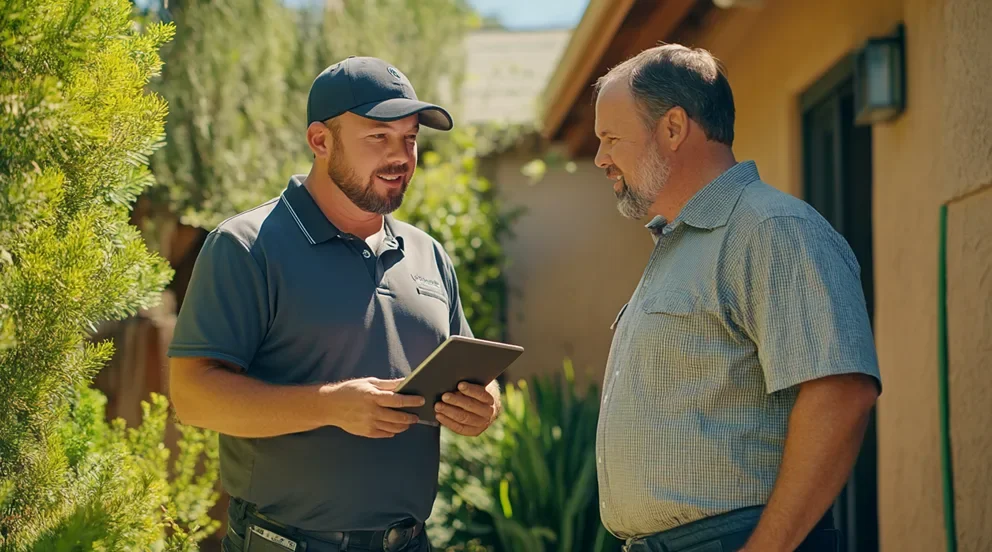If you’ve spent any time in the plumbing industry, you already know that the job doesn’t end when the wrench gets packed up. Getting paid cleanly and quickly matters just as much as fixing the leak or replacing the valve. And that’s where your invoice steps in. A clear, professional plumbing invoice backs your work, keeps your books straight, and shows customers you run a legit, dialed-in operation.
In this guide, we’re laying out plumbing invoice examples you can actually use. Whether you’re building one from the ground up or tweaking your current setup, we’ll walk through what to include, how to handle different job types, and a few tools to make the process smoother. Here’s what we’ll cover:
- 10 key components of any plumbing invoice
- 4 plumbing invoice examples you can build yours off of
- 3 types of plumbing invoices every contractor should have
- 6 tips to create plumbing invoices that speed up payments
- 4 common invoicing questions plumbing pros ask
Let’s kick things off by breaking down what a solid plumbing invoice needs to cover.
10 key components of any plumbing invoice
Plumbing invoices should be clear, detailed, and professional. Missing information can delay payments, confuse clients, or lead to extra back-and-forth that no one has time for. To keep things tight and on track, here’s what every plumbing invoice should include.
- Company header – The invoice should clearly show who it’s coming from. Include your company’s name, address, phone number, email, and license number (if required). This makes it easy for the client to identify your business and reach out with any questions.
- Customer information – Every invoice needs to be addressed to the person or business that requested the work. Include their name, service address, and contact details. This helps avoid confusion, especially when dealing with property managers or multi-site clients.
- Invoice number – Each invoice should have its own unique number. This makes tracking easier on your end and simplifies things for the customer if they have questions about specific jobs or payment history.
- Service and invoice dates – Include the date the work was completed, the date the invoice was issued, and the due date for payment. Clear timelines keep expectations aligned and help reduce late payments.
- Work performed – This is where you break down the job. Include a clear list of the work done—whether that’s unclogging drains, replacing shut-off valves, or installing new fixtures. Detail parts used, labor hours, and any other relevant charges so the customer knows exactly what they’re paying for.
- Itemized services and materials – For each service or material, list the description, quantity, unit price, and line total. This gives a transparent breakdown of costs.
- Amount due – Show the total amount the customer owes. List the subtotal, taxes, and any discounts. This section should be clear and easy to read so there’s no guesswork involved.
- Payment terms – Explain how and when payment should be made. Outline accepted methods—such as check, card, or bank transfer—and mention any late fees or penalties tied to missed due dates.
- Additional notes or policies – Include any special terms, warranty details, or instructions relevant to the work or payment. This helps clarify expectations.
- Final message – End with a short thank you or quick note. This is a good spot to suggest a maintenance check-up, offer a future discount, or just let the client know you appreciate their business.
4 plumbing invoice examples you can build yours off of
We’ve shown what to include in a plumbing invoice, but sometimes it helps to see real examples. The ones below aren’t just for show—they’re functional templates or tools you can actually use. Whether you’re handling residential repairs or commercial installs, these examples can help you build invoices that look professional and make billing easier. Here are 4 to consider:
1. BuildOps
Type: Plumbing service management solution with built-in invoicing features
Most Useful For: Commercial Contractors
BuildOps is a field service management platform tailored for commercial contractors, including plumbing companies. Its all-in-one system includes invoicing features that take the guesswork out of creating clean, detailed invoices. Just select the fields you want, enter the job info, and BuildOps does the rest. BuildOps plumbing invoice software makes it simple to send professional invoices straight to customers while automatically storing each one in your system for recordkeeping. The invoicing features also connect to payment processing, customer profiles, and accounting tools—helping you stay on top of what’s been billed, what’s been paid, and what’s still pending.
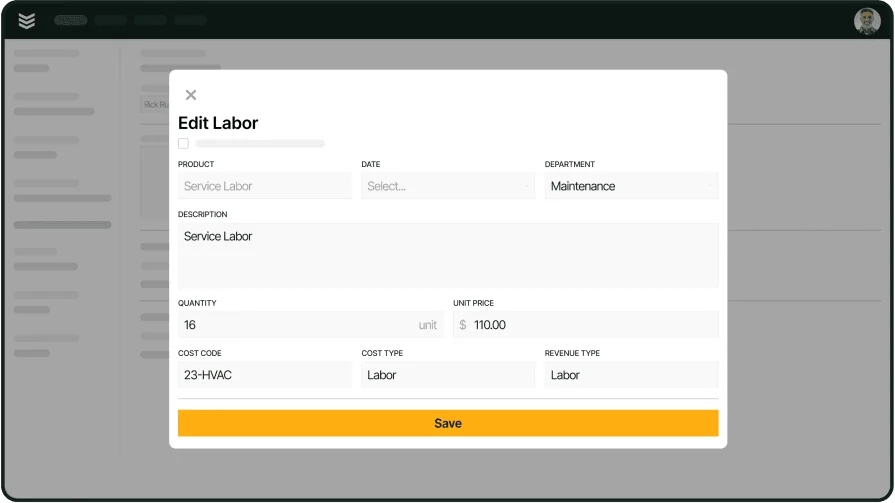
Demo BuildOps Invoicing Tool
Find out how BuildOps invoicing tool helps plumbing contractors get paid faster.
2. Intuit QuickBooks
Image Source: QuickBooks
Type: Downloadable template
Most Useful For: Residential Contractors
QuickBooks offers a free plumbing invoice template you can download in Word, Excel, or PDF. It’s simple to use—just enter your job details, parts used, labor time, and rates, and the totals calculate automatically (in most versions). It’s a fast way to put together an invoice without having to build one from scratch.
That said, this template does come with trade-offs. Not all file formats support digital editing, and some may not handle price formatting properly. Each time you need to send a new invoice, you’ll have to re-enter the info and save a new copy—so there’s more manual work involved than with invoicing software.
Get the free downloadable plumbing invoice template from Intuit QuickBooks.
3. FreshBooks
Image Source: FreshBooks
Type: Free downloadable templates
Most Useful For: Independent Plumbers and Small Plumbing Businesses
FreshBooks offers a collection of free plumbing invoice templates available in various formats, including Word, Excel, and PDF. These templates are designed to help plumbers create professional and detailed invoices quickly. You can customize them to include your business details, services provided, costs, and payment terms.
While these templates provide a solid foundation for invoicing, they do require manual entry for each new invoice. Calculations for totals and taxes need to be performed manually, which can be time-consuming as your client base grows. For plumbers managing a higher volume of clients or seeking more automation, exploring comprehensive invoicing software might be beneficial.
Download the free plumbing invoice templates from FreshBooks.
4. Jobber
Image Source: Jobber
Type: Invoice Generator
Most Useful For: Independent Plumbers and Small Teams
Instead of using a static template, Jobber offers a free online plumbing invoice generator. You can customize it with your company logo, add client info, list out services, parts, pricing, taxes, and even apply discounts. Once complete, Jobber calculates the totals and gives you a clean PDF you can send or save.
But keep in mind—you’ll need to manually fill out the info every time. You can’t download or reuse a base template, which means re-entering your company details for each invoice unless you’re using their full platform. If multiple people on your team are handling billing, this can also create some version control headaches. Still, for solo plumbers or small teams handling a few jobs a week, it’s a solid way to build sharp-looking invoices without needing extra software.
Check out Jobber’s free and customizable plumbing invoice template
3 types of plumbing invoices every contractor should have
Plumbing work covers a wide range of jobs—routine service, emergency repairs, and system installations. While the core of each invoice stays similar, having specific invoice templates for each type of job can save time, reduce mistakes, and make billing easier for both you and the customer.
We recommend keeping a few key types of plumbing invoices on hand:
- Plumbing service invoice: These are used for regular plumbing maintenance, inspections, or small service calls. Whether it’s checking water pressure, flushing a water heater, or replacing a worn valve, this invoice is best for recurring or one-off jobs that don’t involve major parts or labor. It’s clean, simple, and easy to fill out after routine calls.
- Plumbing repair invoice: Repairs are one of the most common plumbing requests, and this invoice should capture the full scope of the fix. That includes diagnostics, parts used, labor hours, and any additional fees—like after-hours service or cleanup. Having a dedicated repair invoice helps document exactly what went wrong, what was done to fix it, and what it cost.
- Plumbing installation invoice: This one’s for bigger jobs—installing water heaters, sump pumps, whole piping systems, or bathroom/kitchen fixtures. It should include pricing for the unit or materials, installation time, any permits or haul-away costs, and a full breakdown of labor. A solid installation invoice ensures your customer sees the value of the full project and understands where their money went.
Having these invoice types ready to go means your crew can fill them out fast and your customers get a clear, accurate record of the work—no guesswork, no delays.
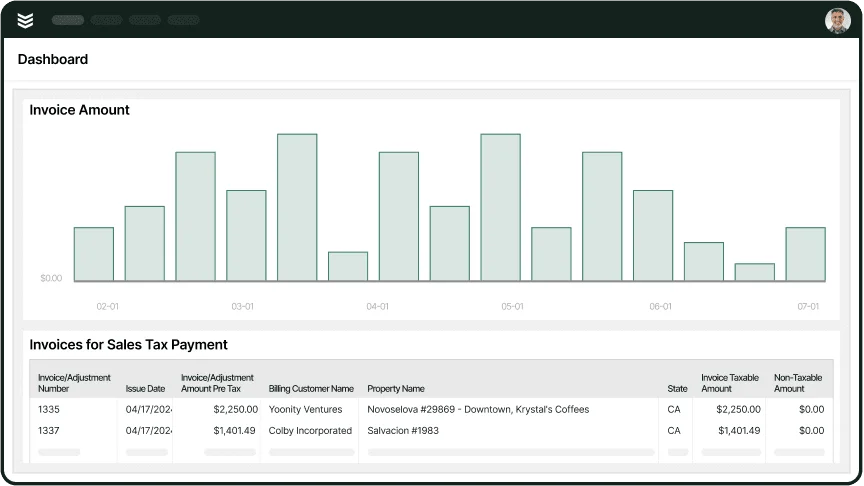
Invoice Plumbing projects with confidence
Use BuildOps invoicing tools to access fully customizable, pre-built templates.
6 tips to create plumbing invoices that speed up payments
The longer you wait to send an invoice, the longer you wait to get paid. That’s not just common sense—it’s backed by invoicing data from thousands of real contractor jobs. Companies that send invoices within 10 days of job completion consistently get paid faster than those that wait 20 days or more. There’s a clear sweet spot for sending invoices that can make a real difference in your cash flow. If you’re looking to tighten up your process, here are six practical ways to make your plumbing invoices faster to send, easier to understand, and more likely to get paid on time:
1. Collect job details from techs immediately after the work is done
Job info is freshest right after the work wraps. That’s when your techs should log what happened—hours on-site, parts pulled from the truck, fittings replaced, and any last-minute fixes. If that data waits until the end of the day—or worse, gets scribbled on a loose sheet—it’s easy to miss key billable items. Make it standard practice to capture this on-site, whether through a mobile app or a structured form. That way, your office team isn’t chasing down missing details before they can build the invoice.
Expert Tip
Don’t wait to track job details when your field techs get back to the office. Empower them to collect info while on the job with BuildOps plumbing invoice app.
2. Use a template that covers everything—consistently
A clear invoice layout saves everyone time. Your team knows what to include, and your customer sees exactly what they’re paying for. Stick with a structure that covers:
- Business name and contact info
- Job location
- Service description
- Breakdown of parts and labor
- Tax, subtotal, and final amount
- Payment terms and methods
Sending invoices that vary from job to job only adds confusion. A consistent format keeps things simple and professional.
3. Make sure customer billing info is accurate every time
Wrong email. Outdated contact. Misspelled name. These small details can stall a payment for weeks. Always verify billing contacts before sending anything—especially if you’re working with property managers or general contractors who have specific approval chains. Have a system in place to confirm contact info at the time of booking. That small step up front saves headaches later.
4. Display payment terms where they’ll be seen
Don’t bury terms like “Net 15” in small print. Spell them out clearly: “Payment due within 15 days of the invoice date.” Place them near the total so the customer can’t miss them. Also, be clear about what you accept—card, ACH, check, or online portal. If you leave it vague, expect delays and phone calls asking how to pay.
5. Offer multiple payment methods to remove barriers
Giving your customer more ways to pay makes the process faster and improves their experience. By offering multiple payment options, such as credit cards, direct transfers, or online payment links, you reduce the chance of delays and accommodate different preferences. This also demonstrates your commitment to customer convenience, which can lead to increased satisfaction and loyalty.
6. Add a closing message that builds trust
The invoice doesn’t have to end cold. A short note at the bottom—thanking them for their business or reminding them about recommended service intervals—goes a long way. You can even mention upcoming availability for follow-up work or offer a small return discount if that fits your process. That extra touch reinforces professionalism and keeps your company top of mind for the next job.
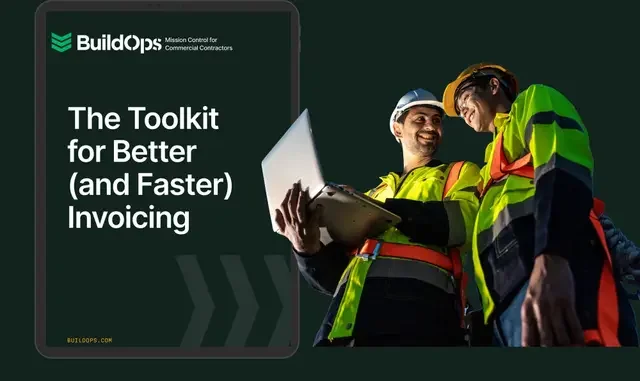
Want templates, tools, and tips in one place?
Use BuildOps to create professional invoices that get you paid faster.
4 common invoicing questions plumbing pros ask
When it comes to invoicing, plumbing contractors run into plenty of real-world questions that don’t always get answered in generic templates. Whether you're billing for a quick repair or a multi-day install, the details matter. Below are some of the most common invoicing questions plumbing pros ask—and how to handle them.
1. What should I do if a plumbing client disputes an invoice?
Start by reviewing the invoice against your job notes, material list, and the original scope of work. Reach out to the client quickly, explain the charges clearly, and walk them through the breakdown. If there’s an error, fix it right away. If not, stay firm—your documentation backs you up.
2. How detailed should a plumbing invoice be for small service calls?
Even for minor jobs, include a brief job description, time on-site, materials used, and final cost. Clear details prevent confusion and make you look more professional. It also helps build trust for repeat work.
3. Can I use the same invoice format for both service and installation jobs?
You can, but it’s better to have variations. Installation jobs often involve more parts, labor, and permit-related fees—having a tailored layout makes those details easier to present and process.
4. What’s the best way to invoice plumbing work done over multiple visits?
Use progress billing or split invoices. Document each visit’s scope, time, and charges separately, then tie it all into one running invoice or final summary. This keeps billing transparent and manageable for both you and the client.
BuildOps goes beyond basic plumbing invoice templates. It gives your team a connected field service platform designed to handle invoicing with less back-and-forth. Job details entered on-site automatically feed into your invoice draft, so you’re not chasing down paperwork or missing line items. You’ll also get built-in tools for tracking job history, managing multi-location clients, and organizing customer records in one place.
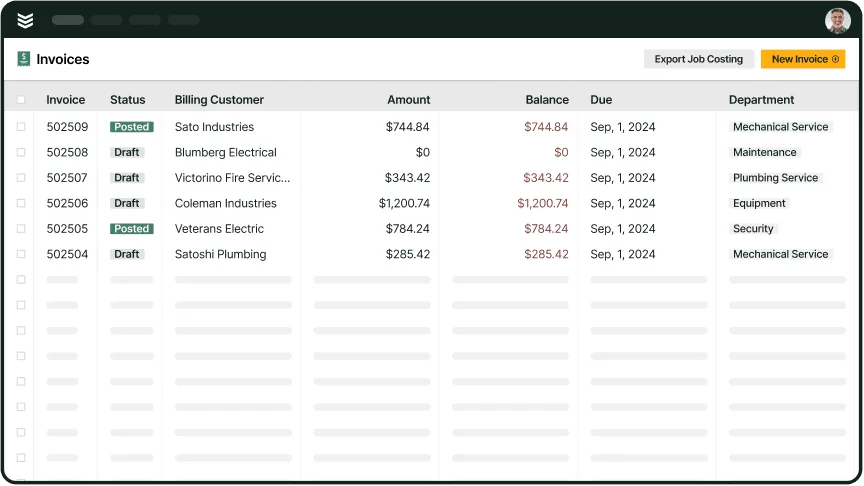
Demo BuildOps invoicing tool
See how we help commercial plumbing contractors tighten business operations.



